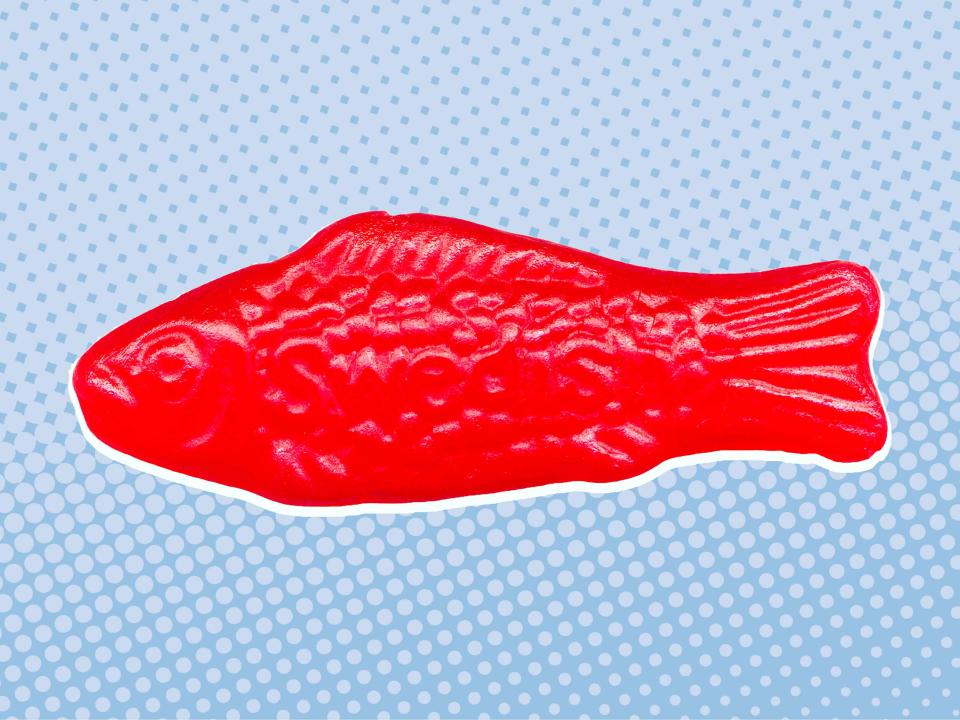You’ll Never Guess What Swedish Fish Are Actually Supposed to Taste Like
Hint: It's not cherry.

Getty Images/Allrecipes
Swedish fish, with their eye-catching red color and bright yellow packaging, have cornered the market on movie theater snacking. They are the 10th most popular movie theater candy in the U.S., and when October rolls around, Swedish Fish skyrocket in popularity as well—they’ve been in the top 20 most popular Halloween candies for years.
But compared to many other American candy favorites, Swedish Fish are a bit odd. First off, they’re fish-shaped, which is an unusual shape for candy in the States. And more importantly, folks have been speculating for years over what exactly the flavor of these red treats is.
What Are Swedish Fish?
Swedish fish are a bright red, gummy candy hailing from Sweden. Malaco, a Sweden-based candy company, produced them among other fruity, gummy candies. Swedish fish don’t contain gelatin, so they have a sticky, chewy texture as opposed to the bouncy texture you would get from gelatin-based gummies in the U.S.
Since Swedish fish are from Europe, they’re often referred to by the European terms “starch jellies” or “wine gums.” But don’t worry, these sweet treats don’t contain any alcohol; the term just means little pastille-type candies that one might savor, like wine.
Malaco introduced Swedish fish in the 1950s, and after a distribution partnership with Cadbury, they caught on here in the States. Now, the Swedish fish we see lining the candy store shelves are manufactured in Canada or Turkey. You won’t find a lot of fish-shaped candy in the U.S., but many types of wine gum come in aquatic shapes, and the fish shape specifically came about due to the heavy fishing economy in Sweden.
What Flavor Are Swedish Fish?
Given their bright red hue, you might expect Swedish fish to be cherry, strawberry, or fruit punch-flavored. However, Swedish fish are actually lingonberry-flavored.

TorriPhoto/Getty Images
What Is a Lingonberry?
Strawberries, raspberries, and blueberries grow wild all over the U.S., and as such, it’s easy to find these berries popping up in jams, baked goods, and even candy all over the country. In Scandinavia, the lingonberry is as popular, if not more, and is just as common as strawberries are to us. In countries like Sweden and Denmark, lingonberry jam is a breakfast table staple served alongside Swedish pancakes and a common ingredient in syrups for desserts and even soda.
From the outside, you might mistake a lingonberry for a cranberry; it’s a small, round, bright red berry, though slightly smaller and more spherical than a cranberry. They’re from the same family of plants, so they share many of the same physical characteristics as well as the extremely tart pop cranberries are known for. Though they’re most popular in Scandinavian countries, lingonberries do grow in some places in North America, primarily in the Pacific Northwest and some parts of Canada. Lingonberries are sour but have a fruity sweetness that many people describe as similar in flavor to raspberries, pomegranates, or currants. Lingonberries are very juicy, which makes them perfect for jams and sauces. Alone, they can be overwhelmingly tart, but when mixed with sugar and other ingredients, their mellow sweetness shines through.
If you’ve ever dropped by the food court of the Swedish furniture store Ikea, you’ve likely seen a small dollop of the sweet-tart lingonberry jam mounded up next to some Swedish meatballs and gravy. Lingonberries’ natural tartness and the added sugar make them perfect to cut through ultra-savory and fatty flavors like meatballs and gravy.
Are There Other Swedish Fish Flavors?
The classic red lingonberry flavor is the most popular, but there are a few other flavors. In Sweden, a jet black licorice flavor is popular, but it isn’t generally available in North America. Other popular flavors include orange, lemon-lime, and pineapple, the latter being green, not to be confused with the yellow lemon-lime. In 2006, many fans were dismayed to learn that the popular purple grape flavor was being discontinued. Beyond various fruit flavors, you can now find Swedish fish in a variety of sizes, ranging from mini bite-sized fish to ones that fit snugly in your palm.
Read the original article on All Recipes.

